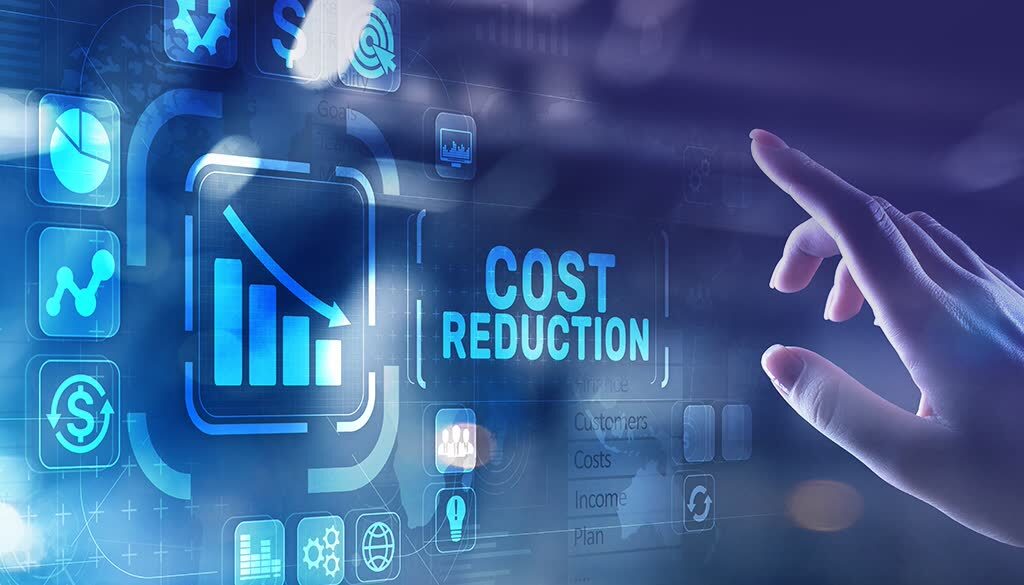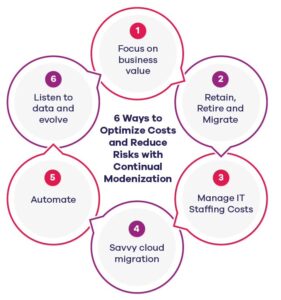Top 6 ways to optimize costs and reduce risks in application modernization

Most organizations end up spending a significant portion of their IT budget to settle their compounding technical debt. With pressure on the CIO to reduce costs, the focus definitely is on optimizing costs and reducing the risks involved in application modernization.
When making plans for application modernization, enterprises often have questions about why application modernization journeys often fail. After all, no one wants their budding initiatives to meet the same fate.
To get right into it, any such initiatives fail due to incorrect estimation of the effort or investment required, improper alignment of stakeholder expectations, or a lack of focus on the user interface, user experience, change management, or end-user training.
These factors can determine whether an application modernization initiative is a success or a failure.
And now more than ever, modern systems are needed. The COVID-19 pandemic has shown the importance of business agility and technologies that can support that agility. The pandemic also accelerated the need for digital services and improved customer experiences, which also require updated systems.
The key is to avoid or reduce technical debt while also creating agile and responsive IT systems through the right application modernization strategy. And the right modernization strategy must account for the constantly changing business needs. In order to determine that strategy, investing in the application assessment and planning will serve you and your modernization efforts well.
And the key to the right modernization strategy? Continuous modernization.
You don’t just try to modernize everything at once. That can be very expensive, and with huge upfront costs. Ensuring that your modernization strategy is continuous will keep your enterprise agile, keep your budget optimized, reduce risks, and keep disruption to a minimum. You will also prevent technical debt from snowballing out of control, which can happen when treating application modernization as an occasional (and expensive) undertaking.
Here are the top six ways to optimize costs and reduce risks as you modernize your legacy systems on a continuous basis.
1. Focus on business value, not age
When deciding which legacy systems to modernize, assess the applications and services that make up the business capabilities you want for your enterprise. Then, figure out which components of your legacy systems are keeping you from having those capabilities.
In other words, which of your applications or the components thereof aren’t delivering business value?
Focus on updating those components rather than the oldest ones. By modernizing only the components that can’t support your goals, you won’t needlessly spend on updating the components of your legacy systems that are, for right now, perfectly sufficient.
2. Determine which applications to retain, retire and migrate
You need to dissect applications into bite-sized chunks of business capabilities, which can then be modernized and delivered in a periodic interval. To set the right priority for which capabilities should be modernized first in your continuous modernization initiative, collaborate with your customers and end users.
In this way, once you’ve identified which components aren’t delivering business value and need to be modernized, you also need to review your application portfolio for business value. It’s common for enterprises to have redundant applications, for instance, because of mergers and acquisitions. It’s also common to have applications that are not even in use.
To cut costs, you need to first gain an understanding of how applications are being used and how often they are used. If an application is found to be not needed, you can retire it. If an application has unused features, you won’t need to needlessly spend on reproducing those features in an updated version.
When it comes to migrating your customers and end users to the new system and getting them up to speed on it, engage them in the early stages. This will ensure that your retraining efforts will be less.
In short, you need to determine how your applications can provide the most business value without overspending and overengineering.
3. Manage IT staffing costs all the way
When it comes to your modernization journey, you need to think about the new skills and tools you’ll need — both during the process and when you make it out the other side.
So, ask yourself: Is your current staff skilled in those new languages and tools?
If your answer is a ‘No’, you have the option to adopt a hybrid mode of “Build” and “Hire”. What do we mean? Your existing workforce is always an asset with deep domain knowledge that may not be easily replaced, so train them (Build) on the latest technology with the help of external experts (Hire). A workforce skilled in legacy as well as modern technologies can be greatly beneficial for the transition and beyond.
To keep staffing costs down, consider consolidating skillsets around fewer products and technology stacks. This will, of course, affect your modernization (and business) decisions, so think carefully.
Technology service providers, managed service providers, and consulting firms are also cost-effective options if you need to augment your staff during your application modernization journey.
4. Be savvy about cloud migration
Although cloud migration is becoming an essential step for any enterprise starting an IT modernization project, you must be smart about it. If you aren’t savvy about it, instead of reducing costs, cloud adoption may increase costs. A savvy adoption of cloud resources can greatly reduce infrastructure, maintenance, and development costs, freeing up the budget to go toward innovation.
Once in the cloud, you can further optimize cloud costs by leveraging multiple cloud services, autoscaling, and using a consumption-based model, especially for applications where demand is variable. This can be done by continuously analyzing the performance and utilization metrics and then provisioning resources up or down to meet your exact demands.
5. Automate, automate, and automate
Implementing automated solutions as part of your modernization efforts can reduce costs, especially in the long term. Bolstered by emerging technologies such as artificial intelligence (AI), machine learning (ML), and robotic process automation (RPA), these solutions can play a crucial support role, helping teams with manual, repetitive tasks. This allows your IT teams to focus on bringing value through innovation and building the business capabilities you need to compete. And as your enterprise grows, automated solutions can scale right along with it, performing tasks such as streamlining workflows, enforcing security policies, and ensuring compliance.
6. Listen to your data and evolve continuously
Just as your continuous modernization strategy is designed to keep costs in check and reduce risks, you also need to ensure that you review the data every step of the way, before, during, and after each phase of your modernization initiative to determine how well your cost-cutting strategies are working. (After all, your modernization efforts are never finished, only paused, if done on a continuous basis.)
Examples of questions to answer with the data: Are you spending less on IT maintenance? Has ROI increased? How has business value improved in relation to costs? Has time to market improved? And just like application modernization itself, checking the data should be a continuous process.

Conclusion
Continuous modernization can reduce costs while also creating more agile, responsive systems that are able to support your business goals. The right partner can help with having a clear strategy, modernizing only what can’t currently support your business goals, upskilling your staff, and taking advantage of emerging technologies enabled by the cloud — while supporting all these decisions with cold, hard data.
What Relevantz Can Do for You
Relevantz can be the partner you need to help you along your application modernization and digital transformation journeys. With our business-first, outside-in modernization approach, Relevantz can help your application modernization initiatives, including the rehosting, replatforming, refactoring, rearchitecting, rebuilding, and replacing of your current enterprise systems. We can also separate the applications from legacy infrastructure, modularize intermingled business processes, liberate data from legacy systems, and innovate new digital systems.
And because our approach is iterative, your enterprise will be able to enjoy all the benefits of new information technologies, such as having the agility to adapt quickly to the demands of the marketplace, while keeping your legacy systems humming behind the scenes.
Do you want to optimize costs and reduce risks with your application modernization?
